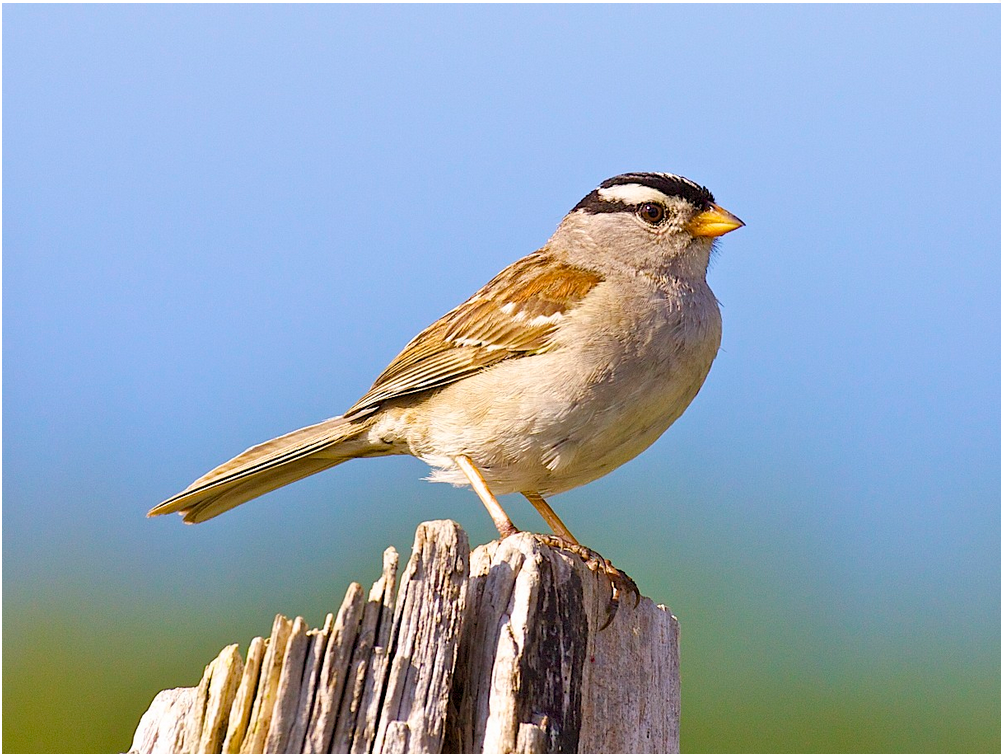White-crowned Sparrow—Photo: Jim Gift
The Crowned Sparrows
November 2022
by Bob Boekelheide
The genus of sparrows known as Zonotrichia is well-represented on the north Olympic Peninsula. The “Zonos,” as they are affectionately called, are the “crowned” sparrows, including five species: White-crowned Sparrow, Golden-crowned Sparrow, White-throated Sparrow, Harris’s Sparrow, and Rufous-collared Sparrow.
According to Words for Birds, a wonderful book about the etymology of bird names, “Zone” in Greek means band or girdle, and “trichias” means a small bird. Consequently, Zonotrichia means “small bird with bands,” referring to the streaked heads found on these birds, which are actually fairly large for sparrows.
Three of the Zonotrichia – White-crowned, Golden-crowned, and White-throated Sparrows -- occur on the Olympic Peninsula every year. White-crowneds nest here in abundance, Golden-crowneds winter here in abundance, and White-throateds occur mostly on migration and sometimes stay for the winter, particularly at feeders. There are a few Clallam records for Harris’s Sparrow, a species found in the center of North America, but not every year.
White-crowned Sparrow, showing its distinctive black-and-white head stripes. Photo by Bob Boekelheide. (Click on photo to enlarge)
Golden-crowned Sparrow, showing its distinctive black eyebrows and golden-yellow crown patch. Photo by Bob Boekelheide. (Click on photo to enlarge)
Rufous-collared Sparrow is the southern outlier, ranging from Central America to the southern tip of South America. If you’ve birded anywhere in South America other than the Amazon rainforest, particularly in the continent’s southern half, you’ve probably seen Rufous-collared Sparrows, one of the most abundant and widespread sparrows in South America.
Our two locally-abundant crowned sparrows, White-crowned and Golden-crowned Sparrows, are very closely related. One genetic study showed that the two species share 99.89 percent of their genome, as high as the genetic variability within some whole species. Studies suggest that the two species may have split apart as recently as 50,000 years ago, likely during one of the most recent glacial advances and retreats in western North America.
There are four subspecies of White-crowned Sparrow, but only one Golden-crowned Sparrow. Two White-crowned Sparrow subspecies largely nest in shrubby habitats across Alaska, Canada, and western mountains, from tree-line forests to tundra willow patches. Two other White-crowned subspecies nest in shrubby habitats on the West Coast from southern B.C. to California, including the Puget Sound White-crowned Sparrows we hear singing on the north Olympic Peninsula. Golden-crowned Sparrows are somewhat wedged in between, mostly nesting at tree line in mountains of western Canada and the southern half of Alaska. Some Golden-crowneds also nest down to sea level in coastal areas of Alaska and western Canada, even on some Aleutian Islands. The two species occur together in southern Alaska, where they occasionally hybridize.
Of interest, the White-crowned Sparrow is one of the most intensely-studied wild birds in the world, sometimes called the “white rat” of song birds. Many early studies with White-crowned Sparrows revealed ground-breaking information about regional song dialects, hormonal changes during breeding and migration, and how young birds learn to sing. There have been far fewer studies with Golden-crowned Sparrows.
The annual cycles of Golden-crowned and White-crowned Sparrows in the Olympic lowlands reveal a fascinating juxtaposition between the two species. As shown by monthly data from the Wednesday morning bird walks in Railroad Bridge Park (Figure 1), they make a complete switch twice each year. Golden-crowned Sparrows, which do not nest here, are abundant as a wintering species between September and April. The locally-nesting Puget Sound White-crowned Sparrows are abundant between April and September, then most of them migrate to coastal California for the winter. Some White-crowned Sparrows stay here during winter, but the remaining winter White-crowneds largely flock with Golden-crowned Sparrows at locations closer to the Strait, such as in Dungeness and Jamestown.
April and September are intriguing months, the peaks of spring and fall migration for both species. On the graph (Figure 1), it looks like White-crowneds and Golden-crowneds occur in similar numbers in April and September, but the two species actually have very different missions. In April, White-crowned Sparrows arrive for nesting and immediately begin singing and setting up nesting territories. Golden-crowned Sparrows are still in flocks, getting ready to migrate north while finishing up their body molt and putting on fat. In September, it’s the reverse. White-crowned Sparrows are intent to migrate south, whereas Golden-crowned Sparrows arrive and settle in for the long winter.
Our Wednesday morning bird walks also reveal changes to these species’ populations over the last couple decades (Fig. 2). On the bird walks, we have counted birds on the same route every week for over twenty years, providing an index to their relative abundance over the years. Looking at the average high monthly counts from 2002 to 2021, the numbers of both species bounce around quite a bit, sometimes more than double from one year to the next, but the long-term trend appears fairly stable over time, even increasing in Golden-crowned Sparrows (Fig. 2).
How do the data from the larger Sequim-Dungeness Christmas Bird Count compare with those from the smaller area at Railroad Bridge Park (Figure 3)? The trend lines from the Christmas Count are quite similar to the Wednesday bird walks over the last 20 years, also showing greater increases for Golden-crowned Sparrows. It appears that the two sparrow populations are doing okay around here.
Looking more closely at the graphs, though, it’s apparent that the peaks and valleys of sparrow numbers do not perfectly line up between RR Bridge Park and the larger CBC. For example, 2013 is one of the lowest years for Golden-crowned Sparrows in the Railroad Bridge Park data, whereas 2013 has the highest count for Golden-crowneds on the Christmas Bird Count. Why the difference? Remember that the Railroad Bridge Park data combines an entire year of bird walks, whereas the Christmas Bird Count is only one count occurring one day in mid-December.
Both White-crowned and Golden-crowned Sparrows are expert singers, producing distinctive songs easily remembered and repeated. A favorite translation of our local Puget Sound White-crowned Sparrow song is “See Me, Pretty Pretty Pretty Me,” starting with two separate notes on different pitches, warbling in the middle, then dropping on the final note.
Songs of White-crowned Sparrows fill the air in the Clallam lowlands during spring and early summer. Just about everywhere you go between April and July around Port Angeles and Sequim, from one end of town to the other, there are White-crowned Sparrows singing in nearby bushes. White-crowned Sparrows sometimes sing loudly at night and are a big contributor to the dawn chorus, much to the chagrin of sleep-deprived humans nearby.
Golden-crowned Sparrows also belt out full songs in the Clallam lowlands, even though they do not nest here. Their songs can particularly be heard when they first arrive in September and before they depart in April. Their common song translates to very mournful three notes descending on a minor key, sounding like “Oh Dear Me.”
Klondike gold miners, digging for gold in the mountains of Alaska and the Yukon, noticed that everywhere they staked a claim there would be Golden-crowned Sparrows singing in nearby willow thickets. The minors called them “Sad Willies,” and translated their three-note descending song as “Don’t Dig Here.”
Based on banding returns, it seems likely that the average crowned sparrow only lives to be one to two years old, provided it fledged successfully. At the other extreme, the oldest banded Golden-crowned Sparrow on record reached 10 years 6 months, whereas the oldest banded White-crowned Sparrow was 13 years 4 months.
Banding studies have shown that both species have fairly high site fidelity not only to nesting areas, but also to where they spend their winters. This means that the adult Golden-crowned Sparrows at your feeder this November may have visited you last November, provided they survived two migrations and a nesting season in between.
Whether you see Golden-crowned Sparrows visiting your feeders in December, or White-crowned Sparrows singing at the post office parking lot in May, please stop and take time to appreciate these amazing birds. Despite the curveballs we humans throw at them, these Zonos seem to be surviving reasonably well in our changing world.
Many interesting facts about sparrows in this story came from Birds of the World, an on-line resource available through Cornell Lab of Ornithology. I highly recommend that all bird aficionados subscribe to Birds of the World, both for the information and to support the Lab of Ornithology.


